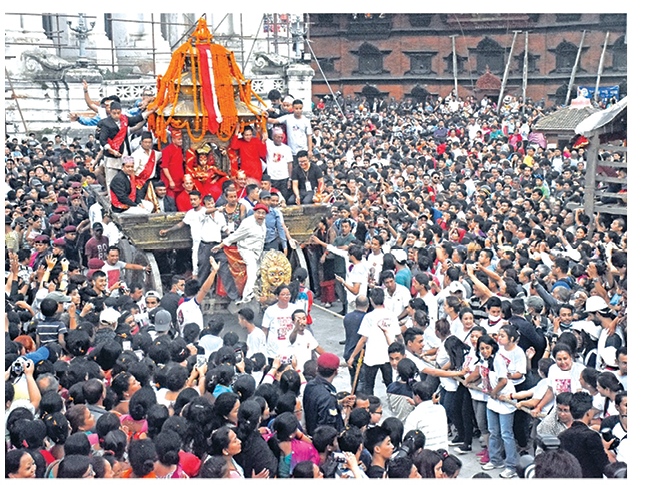
The festival season is upon us. Janai Purnima, Gai Jatra, Indra Jatra and Kushe Aunsi are right around the corner while Dashain and Tihar are also only over a month away.
Giving people a chance to relax, unwind and get together with family members to forget life’s sorrows for a few days, these festivals are occasions of joy and merriment. But they also promote social cohesion and national unity, experts say. “Our festivals play a great role in bringing people from different communities together,” said Dilli Ram Prasai, head of the Department of Anthropology at the Tribhuvan University’s Post Graduate Campus, Biratnagar.
Dashain and Tihar, for instance, are celebrated almost nationally. Despite differences in the particular ways of celebration, nearly all ethnic groups and communities of Nepal observe the festivals with fervour and treat them as occasions to come together and exchange good wishes. So important are they in our national life that even the Maoists used to declare ceasefires, back in the days of the insurgency, to allow people to mark these festivals safely and happily.
“Festivals are a chance for people from all walks of life to come together and share their lived experiences. They do not just belong to one group or ethnicity but are rather common cultural assets for everyone,” Prasai said.
He explained that our festivals developed around nature.
They were a way to mark the seasons or observe specific occurrences. They were also a way to celebrate survival. “In ancient times, people who survived natural disasters or calamities used to gather and hold feasts,” Prasai said, describing that festivals, in their original form, transcended socio-cultural boundaries and embraced the wider concept of humanity.
“That is why their role in fostering unity cannot be understated,” Prasai noted.
Some examples of unifying festivals, other than Dashain and Tihar, include Chhath which is celebrated by all the communities of Mithilanchal regardless of caste and class, and Teej celebrated by most Hindu women across the country.
The Jatras of Kathmandu Valley also show how celebrations can strengthen nationality. No major festival of the valley, be it Yenya Punhi of Kathmandu, Machhindranath Jatra of Lalitpur or Biska of Bhaktapur, to name a few, is executed by a single caste or community alone.
“Every unit has a role to play and everyone contributes. For centuries, the festivals here have served as anchors around which the residents of Kathmandu have coalesced,” said culture scholar Om Dhaubhadel.
In Indra Jatra, for instance, the nine oil-presser (Manandhar) wards are responsible for the selection, transport and erection of the sixty feet high sacred Yansi pole, the Jyapu farmers perform the Devi Pyakha (Goddess Dance) and are involved in conducting numerous processions throughout the Jatra period, a Putuwar from Balaju keeps watch over the Yansi for eight days, a Kusle musician comes and plays the oboe at its
feet every day until it is felled, Hindu Rajopadhyayas and Buddhist Bajracharyas act as priests for the images of Indra put on display at Indrachowk, Maru, Kilagal and Nardevi and the mask of the Dagi is kept at the house of a Tuladhar family near Kasthamandap. Since the ascension of Prithvi Narayan Shah to Kathmandu’s throne, various non-Newa castes have also played important roles for the successful conduction and completion of the festival.
“Every caste plays a vital role for the completion of the Jatra and no task is judged big or small. All those engaged in the festivity are equally important,” Dhaubhadel said.
Broadly too, issues of culture have always unified Newas all across the country. “When it comes to culture, no one is seen as high or low caste, rich or poor or affiliated with one political party or the other. They are just Newa,” Dhaubhadel elaborated.
This unity was seen in 2019 when people all across Kathmandu Valley erupted in protest against the Guthi Bill. Even Newa politicians belonging to the ruling party of the time, Nepal Communist Party, criticised the bill and participated in demonstrations against it.
Nepal’s festivals have crossed geographical, racial and ethnic boundaries and bonded different groups and communities for centuries, both Prasai and Dhaubhadel noted. However, they have started becoming exclusionary in recent years, particularly economically, Prasai stated.
“Excess and pomp have made festivals unaffordable for the poor. Too much emphasis on materialism has prevented the economically disadvantaged families from participating in and enjoying the celebrations,” Prasai said. “However, if we get rid of ostentation then festivals, at their core, are still unifying ingredients in our society.”
Source : TRN,





